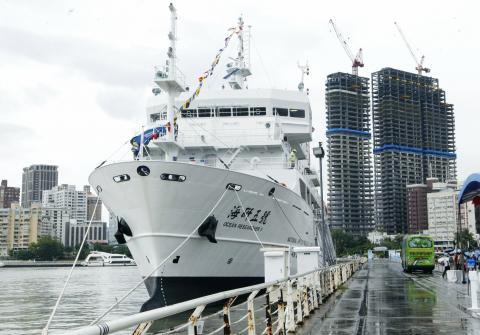Ocean Researcher V, the largest ocean research vessel designed and built in Taiwan, was officially handed over to the National Applied Research Laboratories (NARL) yesterday.
The 2,700 tonne ocean research vessel, measuring 72.6m in length and 15.4m in width, has a boarding capacity of 18 crew members and 30 scientists and is now docked at Greater Kaohsiung’s Singda Harbor.
The vessel was funded by the National Science Council (NSC), which commissioned the task to the NARL’s Taiwan Ocean Research Institute (TORI).

Photo: CNA
TORI’s Deep Ocean Exploration Division manager and associate researcher Yang Yih (楊益) said the Ocean Researcher V differs from the three existing ocean research vessels because of its expanded tonnage, which gives it enough resistance to cope with strong waves caused by the northeast monsoons in the winters and allows it to gather research data that in the past was difficult to collect.
Moreover, the vessel’s maximum endurance is expanded to 50 days and a maximum range of 13,000 nautical miles (24,076km) for each single expedition, Yang said, adding that its core mission is not limited to fundamental ocean science research and that it can also perform the government’s ocean energy exploration assignments.
TORI’s Nearshore Observation and Modeling Division and Marine Exploration Technology Division manager and researcher Yang Wen-Chang (楊文昌) said the vessel is scheduled to make research expeditions for a total 250 days a year. Of these 250 days, 100 days would be allotted to academic science research projects funded by the NSC, while the remaining 150 days would go to the NARL’s research projects, governmental assignments or business sector research trips.
TORI director-general Kao Chia-chuen (高家俊) said the two special features of the Ocean Researcher V are its propelling force — which relies on electricity, allowing it to move slowly yet quietly, traits necessary for conducting precise detection operations — and its dynamic positioning system — which allows it to remain steadily at a single spot at sea, undisturbed by strong winds or waves.
In addition to its observational capabilities, such as high-resolution imaging of the sea bed, the vessel can also collect samples deep under the sea’s surface with the use of a remotely operated vehicle (ROV), which can go as deep as 3,000m, Yang Yih said, adding the ROV is planned to be used in research projects exploring sea-floor gas hydrate near southern Taiwan.
Lu Pei-ling (呂佩玲), deputy director of the Central Weather Bureau’s seismology center, said TORI has also agreed to use the new vessel to assist the bureau with the maintenance of submarine cables off the coast of eastern Taiwan, which would improve the precision of earthquake forecasts in Taiwan.
At present, NT$1.82 billion (US$61 million) has been spent on the vessel, while an additional NT$600 million to NT$700 million is to be spent on the acquisition of more research equipment, Kao said.
The vessel is scheduled to embark on its first expedition in January next year, while adjustments to the existing equipment, purchase of new equipment, as well as further training for the crew members, would continue in the coming months, he added.

An essay competition jointly organized by a local writing society and a publisher affiliated with the Chinese Communist Party (CCP) might have contravened the Act Governing Relations Between the People of the Taiwan Area and the Mainland Area (臺灣地區與大陸地區人民關係條例), the Mainland Affairs Council (MAC) said on Thursday. “In this case, the partner organization is clearly an agency under the CCP’s Fujian Provincial Committee,” MAC Deputy Minister and spokesperson Liang Wen-chieh (梁文傑) said at a news briefing in Taipei. “It also involves bringing Taiwanese students to China with all-expenses-paid arrangements to attend award ceremonies and camps,” Liang said. Those two “characteristics” are typically sufficient

A magnitude 5.9 earthquake that struck about 33km off the coast of Hualien City was the "main shock" in a series of quakes in the area, with aftershocks expected over the next three days, the Central Weather Administration (CWA) said yesterday. Prior to the magnitude 5.9 quake shaking most of Taiwan at 6:53pm yesterday, six other earthquakes stronger than a magnitude of 4, starting with a magnitude 5.5 quake at 6:09pm, occurred in the area. CWA Seismological Center Director Wu Chien-fu (吳健富) confirmed that the quakes were all part of the same series and that the magnitude 5.5 temblor was

The brilliant blue waters, thick foliage and bucolic atmosphere on this seemingly idyllic archipelago deep in the Pacific Ocean belie the key role it now plays in a titanic geopolitical struggle. Palau is again on the front line as China, and the US and its allies prepare their forces in an intensifying contest for control over the Asia-Pacific region. The democratic nation of just 17,000 people hosts US-controlled airstrips and soon-to-be-completed radar installations that the US military describes as “critical” to monitoring vast swathes of water and airspace. It is also a key piece of the second island chain, a string of

The Central Weather Administration has issued a heat alert for southeastern Taiwan, warning of temperatures as high as 36°C today, while alerting some coastal areas of strong winds later in the day. Kaohsiung’s Neimen District (內門) and Pingtung County’s Neipu Township (內埔) are under an orange heat alert, which warns of temperatures as high as 36°C for three consecutive days, the CWA said, citing southwest winds. The heat would also extend to Tainan’s Nansi (楠西) and Yujing (玉井) districts, as well as Pingtung’s Gaoshu (高樹), Yanpu (鹽埔) and Majia (瑪家) townships, it said, forecasting highs of up to 36°C in those areas